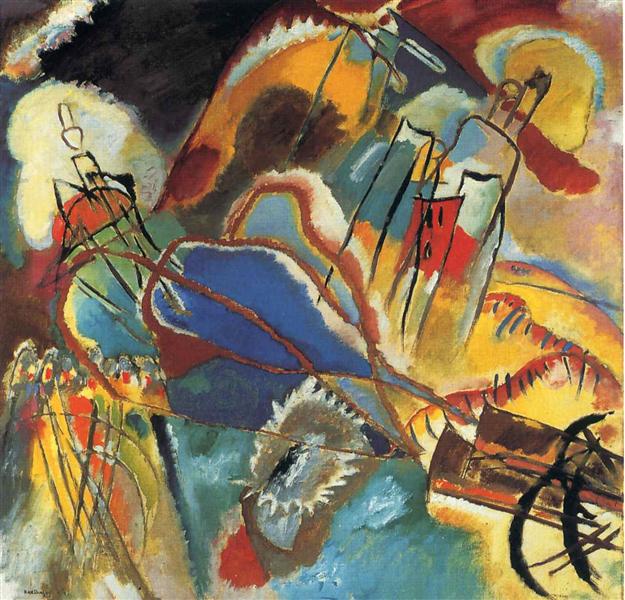Description
The painting "Improvisation 30 (cannons)", created by Wassily Kandinsky in 1913, is erected as a paradigmatic example of the artistic impulse that the master Russian cultivated throughout his career. In this work, Kandinsky enters an intense exploration of abstraction and emotional expression, defining characteristics of his style. From the beginning of his career, Kandinsky understood that art had to go beyond mere representation and look for a direct connection with the viewer through shapes and colors.
When observing "improvisation 30", one is immediately captured by the complexity of its composition. The work, which is registered within the expressionist movement, is a vibrant burst of colors and shapes that seem to be in a constant flow state. The nuances of blue, black, yellow and red are intertwined in a visual symphony that evokes a strong sense of conflict and dynamism. This is particularly resonant when considered the historical context in which it was created, just before the outbreak of World War I. Kandinsky, apparently, sought to capture through this canvas the anguish and desolation that the imminent war had raised in its surroundings.
The work lacks recognizable human figures, which enhances the idea that Kandinsky sought to transcend the figurative to deepen the abstract. However, the reference to the "cannons" in its title suggests a war interpretation. Although there are no direct representations of weapons, strong strokes and angular forms evoke the rumble of conflict. The energy of the composition is palpable, overwhelms and wraps to the viewer, suggesting a struggle and resistance narrative.
Kandinsky is based on color and form principles that transcend conventional meaning, creating in this work a tense and enveloping atmosphere. The colors are organized so that they establish not only visual, but also emotional relationships. For example, the use of vibrant red, which is felt almost as if it were in motion, could be interpreted as a symbol of danger or urgency, while the most off blue could refer to sadness and desolation of war.
By placing "improvisation 30" in the broader context of Kandinsky's production, we observe that this work is part of a series of improvisations where the artist is allowed to express his internal world directly and without restrictions. This type of work is distinguished by its approach to improvisation, a technique that Kandinsky considered the purest form of artistic expression, since it reflects emotions and thoughts at the time of creation. His contemporaries, as well as artists who came later, found in this approach a source of inspiration to explore the potential of color and abstraction in art.
"Improvisation 30 (cannons)" not only represents a strong and emotional artistic statement, but also registered within a revolutionary legacy that defies the rules of representation. Kandinsky, through his pictorial vision, invites the viewer to participate in a sensory experience that transcends the limitations of conventional language, opening the door to multiple interpretations and emotional resonances. Thus, this work becomes an unavoidable reference for those who seek to understand the paths that modern art has traveled and the importance of abstraction in the search for an authentic expression of the human being.
KUADROS ©, a famous paint on your wall.
Hand-made oil painting reproductions, with the quality of professional artists and the distinctive seal of KUADROS ©.
Art reproduction service with satisfaction guarantee. If you are not completely satisfied with the replica of your painting, we refund your money 100%.

